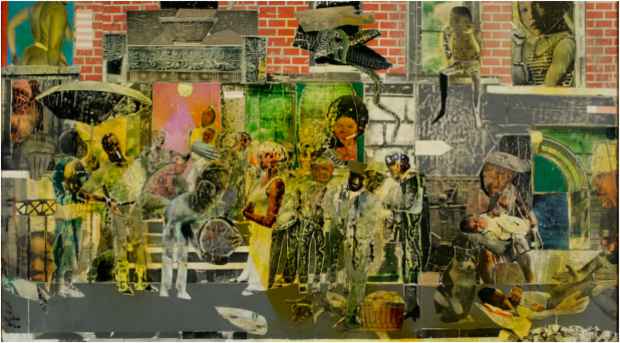Romare Bearden "Urban Rhythms and Dreams of Paradise"
ACA Galleries

This event has ended.
"Exactitude ain’t interesting." Nor is exactitude truth, as Bearden well knew when he made that statement in an interview in 1985.
Romare Bearden (1911-1988) understood the difference between fact and truth. Facts on their own could be untrustworthy; cold data imparting nothing about the lived experience. Facts are simply the exactitude that "ain’t interesting."
Bearden’s art is deeply interesting because it always tells the truth, perhaps most profoundly in his collage work, where bits of “fact”—photographs, magazine ads, textiles, found objects of every sort; literally pieces of the so-called real world—are incorporated into abstracted compositions that traffic in raw, recognizable, uncompromising truth.
From the very beginning and throughout Bearden’s career, the work of African American artists was met with varying degrees of acceptance; less, in the early years of the twentieth century; more, as the century advanced and the struggle for racial equality and civil rights assumed a place in American culture and politics. Activists and artists expressed Black America’s anger over what the poet Langston Hughes called "the dream deferred." Bearden’s art, an important voice in the struggle for civil rights, showed us something even more powerful than anger in the African American community: life.
Bearden’s collages of African American life and aspiration didn’t ignore anger but expressed it instead as passion; passion for the public gatherings and private intimacies of the Harlem street; for the bare-floored rituals of the Black south; for the ecstasy experienced in the church and in the religious traditions of the Caribbean Islands. Bearden presented the totality of African American life, its joys and its struggles, and he saw that life as creative; propelled by the rhythms of the city and the full-throated harmonies of paradise and dreams. In many ways, Bearden’s collages are indeed like musical compositions, the assembled bits and pieces of real-world elements functioning as notes in a song that tells not just the fractured "facts" of African American life but the truth-telling the soul of that life.
For Bearden, then, the goal of achieving civil rights didn’t just mean the acceptance of black people into the American mainstream; it meant the acceptance of the African American way of life, all of it, the hard and the soft of it, as a legitimate component of America itself. But Bearden was no mere propagandist. He was first and foremost a disciplined artist, worldly and sophisticated, and fully aware of art’s traditions. ACA Galleries’ exhibition, “Urban Rhythms and Dreams of Paradise,” celebrates Bearden’s narrative vision but also his genius as an artist, particularly his mastery of the medium of collage. Considered one of the finest collagists of American art, Bearden maintained his connection to painting and draftsmanship. Classic skill and finesse of technique were not sublimated to the readymade components he incorporated into the picture. Bearden placed high importance on composition, carefully organized and balanced, to serve as the girder for the abstracted figurative shapes that roam the surface. And the abstractions themselves are anchored in realism; earlier in his career a strict Cubist, Bearden enjoyed Cubism’s adventurous energy, its willingness to bust things wide open and redefine everything, including art itself. But Bearden also recognized Cubism’s limitations in expressing the more soulful aspect of humanity, leaving out what was for him the very core of the truth he was striving to tell. He developed a somewhat more representational approach to figures, abstracting their forms to infuse them with energy but rendering their forms recognizable as human beings whose emotions are visible on their faces, in their postures, and engaged in their activities.
Bearden’s vision has triumphed. He is now recognized not just as significant African American artist but as an important force in the full American story. His work is collected by major museums and institutions, among them the Metropolitan Museum of Art, the Museum of Modern Art, the Smithsonian Institution, the Art Institute of Chicago and others. He was honored with the National Medal of Arts in 1987, nine months before his death in March of 1988.
ACA Galleries’ exhibition “Urban Rhythms and Dreams of Paradise” is part of the gallery’s celebration of eighty years of championing American art of social relevance. Established in 1932, ACA Galleries continues in this tradition, exhibiting masterworks of the twentieth century and giving voice to the artists of the twenty-first.
Media
Schedule
from November 13, 2012 to February 02, 2013
Panel Discussion: Thursday, December 13 from 6 to 8pm “Remembering Romy” with Myron Schwartzman, Russell Goings and Andre Thibault/Teabo
Opening Reception on 2012-11-17 from 14:00 to 17:00